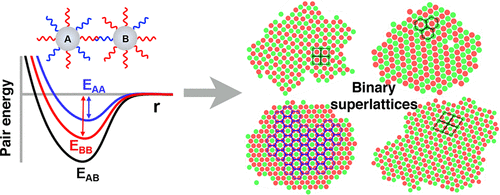Our official English website, www.x-mol.net, welcomes your
feedback! (Note: you will need to create a separate account there.)
Binary Superlattice Design by Controlling DNA-Mediated Interactions
Langmuir ( IF 3.7 ) Pub Date : 2017-11-20 00:00:00 , DOI: 10.1021/acs.langmuir.7b02835 Minseok Song 1 , Yajun Ding 1 , Hasan Zerze 1 , Mark A. Snyder 1 , Jeetain Mittal 1
Langmuir ( IF 3.7 ) Pub Date : 2017-11-20 00:00:00 , DOI: 10.1021/acs.langmuir.7b02835 Minseok Song 1 , Yajun Ding 1 , Hasan Zerze 1 , Mark A. Snyder 1 , Jeetain Mittal 1
Affiliation

|
Most binary superlattices created using DNA functionalization rely on particle size differences to achieve compositional order and structural diversity. Here we study two-dimensional (2D) assembly of DNA-functionalized micron-sized particles (DFPs), and employ a strategy that leverages the tunable disparity in interparticle interactions, and thus enthalpic driving forces, to open new avenues for design of binary superlattices that do not rely on the ability to tune particle size (i.e., entropic driving forces). Our strategy employs tailored blends of complementary strands of ssDNA to control interparticle interactions between micron-sized silica particles in a binary mixture to create compositionally diverse 2D lattices. We show that the particle arrangement can be further controlled by changing the stoichiometry of the binary mixture in certain cases. With this approach, we demonstrate the ability to program the particle assembly into square, pentagonal, and hexagonal lattices. In addition, different particle types can be compositionally ordered in square checkerboard and hexagonal–alternating string, honeycomb, and Kagome arrangements.
中文翻译:

通过控制DNA介导的相互作用进行二元超晶格设计
使用DNA功能化创建的大多数二元超晶格都依赖于粒径差异来实现成分顺序和结构多样性。在这里,我们研究了DNA功能化的微米级粒子(DFP)的二维(2D)组装,并采用了一种利用粒子间相互作用中的可调差异以及由此产生的焓驱动力的策略,为二元超晶格设计开辟了新途径。不依赖于调整粒度的能力(即熵驱动力)。我们的策略采用了ssDNA互补链的量身定制的混合物,以控制二元混合物中微米级二氧化硅颗粒之间的颗粒间相互作用,以创建组成多样的2D晶格。我们表明,在某些情况下,可以通过改变二元混合物的化学计量来进一步控制颗粒排列。通过这种方法,我们演示了将粒子装配编程为方形,五边形和六边形格子的能力。另外,可以在方格棋盘和六边形交替字符串,蜂窝和Kagome排列中按组成顺序排列不同的粒子类型。
更新日期:2017-11-21
中文翻译:

通过控制DNA介导的相互作用进行二元超晶格设计
使用DNA功能化创建的大多数二元超晶格都依赖于粒径差异来实现成分顺序和结构多样性。在这里,我们研究了DNA功能化的微米级粒子(DFP)的二维(2D)组装,并采用了一种利用粒子间相互作用中的可调差异以及由此产生的焓驱动力的策略,为二元超晶格设计开辟了新途径。不依赖于调整粒度的能力(即熵驱动力)。我们的策略采用了ssDNA互补链的量身定制的混合物,以控制二元混合物中微米级二氧化硅颗粒之间的颗粒间相互作用,以创建组成多样的2D晶格。我们表明,在某些情况下,可以通过改变二元混合物的化学计量来进一步控制颗粒排列。通过这种方法,我们演示了将粒子装配编程为方形,五边形和六边形格子的能力。另外,可以在方格棋盘和六边形交替字符串,蜂窝和Kagome排列中按组成顺序排列不同的粒子类型。











































 京公网安备 11010802027423号
京公网安备 11010802027423号